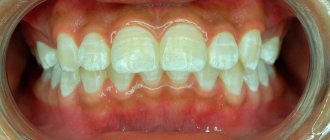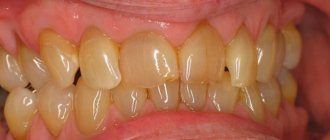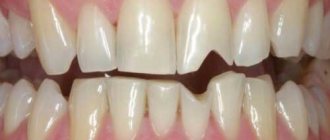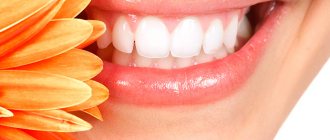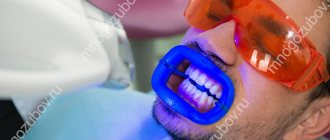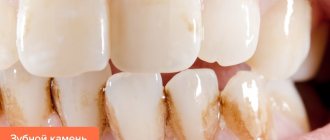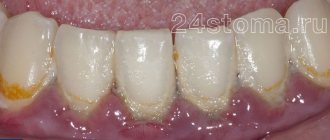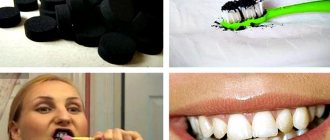Chromogenic components (food, drinks, other products)
The food we eat and other substances we use contain coloring agents (coffee, tea, cola, wine, tobacco, etc.) that can cause yellow, brown or bright orange spots to appear on the skin. teeth In most cases, the discoloration of teeth is generalized, which means that stains tend to form with equal success both on the entire surface of the tooth and in individual areas. If stains appear, it is better to make an appointment with an inexpensive dentist near your place of residence.
Tooth pigmentation - symptoms and treatment
A doctor can make a diagnosis of “teeth pigmentation” by collecting all the necessary data after a survey and examination. If necessary, additional studies are performed.
In modern medicine, there are not many methods for diagnosing tooth pigmentation, so choosing the right one is not difficult. These include:
- visual inspection of clinical manifestations;
- radiography - allows you to evaluate the internal structure of the tooth and identify deviations;
- computed tomography (CT) is a fairly modern research method that is beneficial for both the doctor and the patient (the doctor receives a higher quality image, and the patient receives approximately 90% less radiation); allows you to study the image in 3D format and monitor the dynamics of treatment;
- microscopy - magnifies the area under consideration approximately 25 times, makes it possible to study the structure of the enamel and the extent of the lesion;
- rheodentography - allows you to determine the functional abilities of the pulp, as well as assess the depth of the lesion;
- electroodontodiagnosis is a method of studying the condition of the pulp and periodontium (soft tissues surrounding the root of the tooth) using a dosed electric current that affects the nerve without damaging the tissue membrane of the pulp [8][9].
As a rule, to diagnose ordinary pigmentation, it is enough only to collect complaints, an anamnesis (history of the disease) and a visual examination. Doctors resort to more serious studies, such as CT scanning and a microscope, in case of deeper lesions of the dental cavity and periodontium.
To choose the right treatment method, it is very important to establish a correct diagnosis and not confuse a pigment spot with caries. The latter, unlike dark pigmentation, has a cavity bottom that is not only dark, but also loose.
Superficial caries must also be differentiated from a whole group of non-carious tooth lesions, such as enamel hypoplasia, fluorosis, wedge-shaped defect, erosion and necrosis of hard dental tissues.
With caries, the spot is most often a single one. It is localized in the grooves on the chewing surface or one of the contact surfaces (between the teeth), less often on the neck of the tooth. With hypoplasia and fluorosis, the spots are multiple and localized in places atypical for caries: areas of the labial (cheek) and lingual surface of the tooth crowns.
Spots with hypoplasia are usually white with clear boundaries and have a smooth and shiny surface. They are located at the same level of the crowns of several symmetrically located teeth.
Tooth decay
In the early stages of tooth decay, white spots or spots appear on the tooth enamel. The affected areas lose their natural shine and become dull. A thorough examination reveals the presence of damage to the enamel. If the process of tooth decay progresses, the affected area becomes brown or black, it is necessary to diagnose dental treatment. The damage is initially noticeable as a small dark spot or spots that gradually increase in size (over several months to several years) and often lead to actual tooth decay.
Which doctor should I contact?
Patients with dental pigmentation require accurate diagnosis of the pathology, treatment and, at a minimum, therapeutic assistance. When it comes to the beauty of a smile and problems in the oral cavity, the first thing you need to do is consult a dentist.
If, after the examination, the dentist suspects internal diseases of the body, he will refer you to specialized doctors (for example, a gastroenterologist, endocrinologist). In this case, the treatment should be complex and comprehensive - the dentist will eliminate the consequences, that is, pigmentation, and a highly specialized doctor will treat the cause of the problem.
Caries in the spot stage: diagnosis and treatment features
At the initial stage of caries development, a specific white spot forms on the tooth - it develops due to the penetration of cariogenic microorganisms into the tooth structure. They secrete organic acid, which helps wash out calcium salts. In the absence of timely preventive measures, caries in the stain stage provokes tissue demineralization: gradual softening and destruction of tooth tissue occurs with the formation of a carious cavity.
If you find white spots on the enamel of your teeth, contact your dental clinic for a comprehensive diagnosis. Correct and timely diagnosis will allow you to preserve the beauty of your smile without the need to fill carious cavities.
Disease that causes stains on teeth
A dental disease that manifests itself in the form of multi-colored spots on their surface is called hypoplasia . The disease appears during the gestation period of the future dental patient. It develops in a child if the mother, during pregnancy, had stomach problems, and also had a lack of vitamin D or was exposed to a viral disease.
In such cases, it is necessary to increase the child’s immunity and change his diet. First of all, it is necessary to exclude the possibility of excessive amounts of fluoride entering the body. To do this, you should avoid toothpaste with a high content of it. You need to give your child only purified (bottled or filtered) water, and also give him more vitamins, vegetables and fruits.
With the development of the disease, expressed in the appearance of new spots and an increase in the area of existing ones, remineralization is necessary. The procedure consists of the dentist coating the teeth with a special paste containing substances designed to strengthen the enamel. For hypoplasia detected before the age of eighteen, fluoridation or silvering is also performed.
How to make homemade stain-removing toothpaste
Teeth pigmentation will disappear if you treat them with homemade toothpaste. It will require:
- 50 g white clay;
- 5 g honey;
- a couple of drops of chamomile and sage essential oils;
- 5 drops of propolis.
Another remedy that lightens teeth pigmentation can be made from the following components:
- 3 tbsp. coconut oil;
- ½ tsp. baking soda;
- 1 tsp turmeric powder (it can be replaced with 1 tsp crushed activated carbon);
- 5-10 drops of essential oil (mint, cloves, cinnamon or tea tree);
- a little honey to sweeten.
In both cases, all components must be thoroughly mixed until smooth. You cannot use a soda-based composition all the time. She needs to brush her teeth for 1.5 months, then take a break every other day. If you have caries, you should not use homemade toothpastes. First you need to be cured, and then restore the pigmentation of your teeth.
The advantages of home “bleaches” include:
- absence of synthetic components;
- antibacterial properties;
- prevention of caries, stomatitis;
- normalization of the condition of the mucous membrane, gums;
- affordable price;
- safety in case of accidental ingestion.
There are very few disadvantages to homemade remedies for teeth pigmentation: this paste has an unusual consistency and does not foam much. It is also difficult to wash the brush after using it; this must be done immediately, otherwise the bristles will harden.
Fighting discoloration at home - what can be done
If the pathology is caused by external factors, then you can try to change the shade of the enamel at home. To solve the problem, special gels (for example, Colgate Simply White Night), as well as professional whitening kits with gel for trays (for example, Zoom Nite White and Day White), strips and pencils, and highly abrasive toothpastes are suitable.
Some are trying to correct the situation using folk methods. The most popular are soda and salt, activated carbon, strawberries, banana peel, tea tree oil, lemon.
“I read somewhere that hydrogen peroxide will help whiten unsightly color, so I started applying it to my teeth. There was no effect, but the gums began to burn, and after a while the enamel began to ache. I quit until serious complications developed. I went to the dentist. The doctor scolded me and prescribed 15 procedures to strengthen the enamel, and then recommended, as he put it, not “caveman” methods, but modern methods of whitening using gel with aligners. It ended up not being so expensive, and I’ve been pleased with the results for six months now!”
Viola, fragment of a review from otzovik.com
If you are struggling with pigmentation at home, it would be a good idea to first visit the dentist. First, your doctor will determine your oral health and provide helpful recommendations on what will be effective and safe for you. Secondly, the dentist will remove plaque and prepare the enamel for whitening. Thirdly, the specialist will strengthen the teeth, which minimizes the risk of increased enamel sensitivity and other problems (cracks) after whitening procedures.
On a note! After a professional hygiene procedure, thanks to which it is possible to lighten the enamel by 1-2 tones and return it to its natural shade, many patients abandon the idea of whitening at home, as they remain satisfied with the result.
Folk remedies
Pastes made according to traditional medicine recipes are available to everyone. The components for them can be purchased at any pharmacy or grocery store. Here are the most effective options for homemade bleaches.
Baking soda
This component belongs to active alkaline substances and has pronounced abrasive properties. Baking soda is effective in combating tartar and yellowing of the coating. It is very simple to use: apply a little powder on your finger, lightly massage the surface of your teeth, and rinse your mouth well. It is better not to use a brush so as not to damage the gums with the aggressive component.
Baking soda can also be included in complex whitening products:
- crush several ripe strawberries, add a couple of pinches of the product to the resulting pulp;
- Mix the soda and hydrogen peroxide thoroughly (until a homogeneous consistency).
Attention: if gum bleeding occurs, you should stop using sodium bicarbonate to whiten stains!
You should not brush your teeth with solutions containing soda more than once every 7-10 days. Other contraindications to the use of bicarbonate include:
- coating sensitivity;
- caries;
- enamel damage;
- gingivitis;
- stomatitis;
- a large number of fillings in the mouth.
The main advantage of this whitening method is its high efficiency at an affordable price. You can perform the procedure at any convenient time, without a visit to the dentist.
Among the disadvantages:
- the presence of a large number of contraindications;
- risk of damage to enamel and gums;
- high probability of irritation of mucous membranes;
- increased tooth sensitivity to cold or hot.
To achieve a sustainable result, you will have to use bicarbonate from 2 to 4 months, depending on the severity of the problem.
Lemon juice
This effective natural whitener helps make teeth several shades lighter.
In addition, lemon juice helps:
- prevent the development of caries;
- relieve inflammation of the mucous membranes;
- reduce bleeding gums;
- reduce pain.
There are several ways to lighten enamel using citrus:
- rub your teeth with a slice of fruit, rinse your mouth after 5 minutes;
- combine juice with soda (3:1), use the resulting rinsing solution twice a week;
- Dilute baking soda with lemon until smooth, use the mixture once a week instead of the usual paste.
Attention: patients with thin, sensitive skin are contraindicated from using citrus for whitening!
Another good way to clean and treat your teeth is to treat them every three days with a mixture of lemon juice and crushed eggshells.
Wood ash
Vegetable ash is one of the oldest ingredients used for bleaching. It needs to be crushed into fine dust and rubbed into the enamel.
You shouldn't count on instant results. To achieve a visual effect, several procedures will be required. Between them it is necessary to take a week's break so as not to damage the dental coating.
Activated carbon
Black tablets are an effective sorbent, cleanse the body of internal and external toxins, and are effective against tooth pigmentation and plaque. Activated carbon must first be thoroughly crushed so as not to disturb the enamel structure.
The drug “Gluflutored”
However, not all products are as simple, effective and easy to use as the gel described above. Most drugs can be harmful if used without proper prescription from a doctor, who will instruct in detail and warn against potential risks.
The specialist will tell you how to get rid of external and internal manifestations of pigmentation, how to strengthen tooth enamel and prevent diseases. An effective way to get rid of the problem is to change the chemical composition of saliva by influencing the thyroid gland with a certain set of minerals, vitamins and fluoride for teeth. One of the most common substances used for treatment in clinical settings is Glufluored.
Causes
Pigmentation of teeth (discoloration) is a pathological change in the natural shade of enamel. With such a deviation, the plates can change color to dark brown, pinkish, yellow, or black.
The tooth consists of three parts:
- pulp - internal loose tissue penetrated by nerves and blood vessels;
- dentin, which forms the outer plane (crown), similar in structure to bone;
- enamel - external protective coating.
The natural color of the coating depends on the density and transparency of each of these three layers. The pigmentation of the teeth is distributed unevenly because the layers become thinner from the neck (base) to the edge of the crown.
Discoloration is observed in 85% of people of different ages. In men, tooth pigmentation is much more common than in women (the percentage ratio is approximately 60 to 40). In most cases, the color of the enamel changes in children.
Pigmentation of teeth is often accompanied by mineral depletion of the enamel, which makes the tissue hypersensitive. This brings great discomfort to a person.
Pigment spots on teeth in adults
The nature of enamel discoloration has not been sufficiently studied to date. Dentists agree that there are many reasons that provoke pathology. They are conventionally divided into external and internal.
The first group includes:
- smoking. Once in the oral cavity, nicotine resin penetrates deep into the coating, staining the teeth dark;
- deposits of an infectious nature or stone are localized above the gums, have a yellow color, and a porous structure;
- consumption of products with aggressive natural “dyes”. The most active of them is coffee; the intensity of darkening of the crowns depends on the number of cups of drink consumed per day.
The main internal causes of pathology:
- excess (or lack) of fluoride;
- porphyria is a congenital disorder in the activity of cells that synthesize pigment;
- Cystic fibrosis is a systemic disease that develops against the background of a gene mutation. It is manifested, among other things, by damage to the exocrine glands and mucous membranes;
- age-related changes in the body associated with darkening of dentin, thinning of enamel;
- genetic predisposition;
- long-term use of medications (for example, tetracycline antibiotics) stains teeth yellow or gray;
- materials used in restorative treatment. Thus, a filling made of amalgam (a metal alloy based on mercury) becomes brown over time, and a filling made of resorcinol-formaldehyde paste becomes pink. When the tubules are filled, not only the enamel, but also the gums can darken;
- poor nutrition, as a result of which the body does not receive enough necessary substances.
To get rid of darkening caused by external negative factors, it is usually enough to use whitening pastes or hardware procedures in the dentist’s office. When teeth darken due to the underlying disease, the defect can be eliminated only after a complete cure (or a stable remission has been achieved).
Why does it appear in children?
Pigmentation of teeth in children is a fairly common phenomenon. The main causes of discoloration in children are as follows:
- excessive consumption of sweets;
- irregular oral hyena;
- low calcium absorption;
- dysbacteriosis;
- metabolic disorders;
- early caries (pigmentation of teeth appears even before they change from milk to permanent ones);
- taking iron supplements;
- heredity;
- injuries (mechanical, chemical, thermal);
- avitaminosis;
- improper functioning of the salivary glands;
- sharing cutlery with adults (teeth pigmentation in this case develops due to the transmission of bacteria from mother to child through a shared spoon).
Many parents do not attach due importance to pathology, believing that tooth pigmentation will go away on its own after replacing baby teeth. However, this process is completed completely by the age of 12-13 years. During this time, the infection is transmitted from temporary crowns to permanent ones, as a result, long, complex treatment is required to eliminate the defect.

